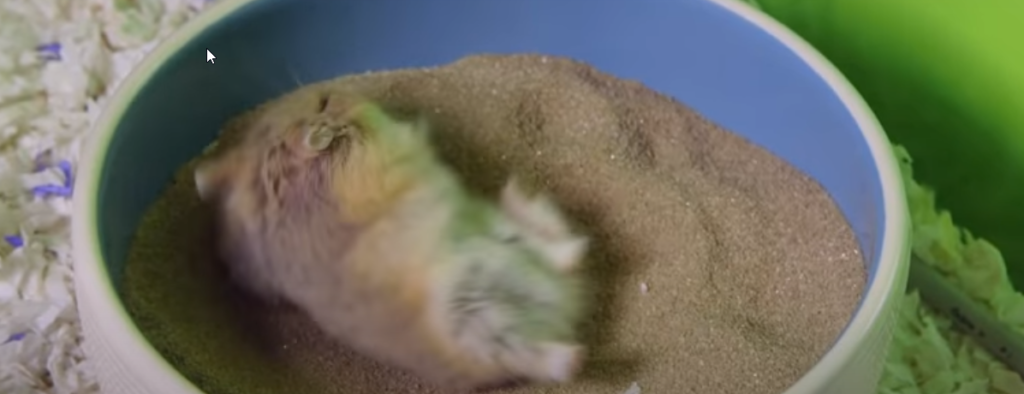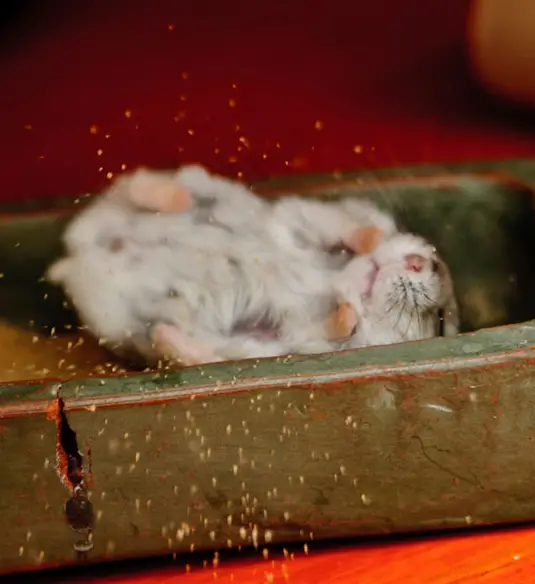Do hamsters need sand baths?
Yes, hamsters need sand baths, it’s the only way for them to clean their fur thoroughly and to get rid of the excess oils that would cover it and also of any other things that would slip into their fur.
Why do hamsters need sand baths?
Hamsters are animals that cannot get wet because this will cause their fur to lose its insulating qualities, and this will expose the hamster to the elements such as cold and heat, a well-entertained fur can avoid your hamster heat stress, especially in hot weather…etc
Hamsters love to roll in the sand and dig in the sandbox because it is the only substrate that is truly natural in the cage.
They also play in the sand and spend time there so they do not get bored, it is an enrichment for your hamster in this sandbox.
It even happens that the hamster sleeps completely on the sand …
Forget about hamster shampoos … and all that crap that only fills the pockets of those who hate nature and don’t give a damn about what is good or not for your hamster…
Just look at the cells in which they lock these poor animals in pet shops and I’m not talking about the pet mills… oh god !!!
So don’t believe everything you hear !!! you should never wet a hamster !!! come on!!!
Ok, let’s continue, to see how hamsters do next to grooming to stay clean.
Hamsters should never get wet:
To keep themselves clean, the only alternative to water, these animals have in the wild is sand, in fact when you walk on a dirt path, you will notice that there are places where the dust is rinsed away by rainwater and a layer or pile of sand has formed instead.
This is what hamsters use to bathe in their natural habitat.
Can you give Hamsters a bath?
No, you should not give your hamster a bath, it is necessary to avoid to wet it except in case of extreme emergency, when it poured a dangerous product for example on its fur or your hamster’s fur is getting oily and greasy since he couldn’t for any reason grooming himself.
In these cases, you can just do Spot-cleaning, by wetting a cloth with warm water and bypassing delicately this cloth, that you have just moistened and wrung out, pass it thus very gently on the place to clean and follow the direction of the hair of your hamster.
Once the area is clean, take a dry towel and wring out the rest of the moisture from your hamster’s fur to avoid putting it back in its cage.
Otherwise, hamsters are serial groomers, they clean themselves well and take sand baths to clean themselves and this is enough to keep them clean.
Water baths are very dangerous for hamsters, so avoid giving your hamster a bath.
What would happen if you give your hamster a shower?
If your hamster gets wet, it may even die in the following days, either from the flu or from a possible cold.
The skin of hamsters, like ours, secretes oils that form an insulating layer, which helps him in his life underground and with the hard life in the open air.
Either Wet tail is certainly caused by the stress of getting it wet ….etc
The fur of the hamster also protects him from attacks of parasites, ticks, and other insects and fungi …
Hamsters also have a kind of olfactory identity that helps them to recognize each other between members of the same family.
If in its natural habitat, a hamster falls for example in a pool of water and manages to get out alive, there is a great chance that its mother will never let it return to the family burrow because it will lose its smell by falling into the water and having its hair cleaned of all the oils that cover it.
Hamsters also hate to get wet because the oils that cover their fur, like their Scent Glands, also leave a scent and an olfactory trace everywhere they go and this helps the hamster find their way back to their burrow even on a moonless night, only with their sense of smell, very sensitive.
You will tell me that my hamster is well installed in his cage, my room is at the ideal temperature and my hamster has excellent bedding with all the nesting material that he needs …etc
Yes, but your hamster knows better than you what he needs and that all this may not be available at any moment, and nature does things well…
Just, don’t give your hammy a shower! Ok… please
Why are water baths not recommended for hamsters?
Your hamster is very sensitive to low temperatures, moreover, if the temperature goes below 20°C, it will begin the process of hibernation.
Hamsters once wet, will have a dry fur, not anointed, and is no longer waterproof and will let the cold, moisture, and heat directly to the skin of the hamster.
A wet fur, even dried afterward, will remain not insulating until the skin of the hamster produces and secretes oils which will discover the hairs and will make them waterproof and insulating.
The hamster will lose its protective oil layer, which also protects it from parasites ….
How does the hamster take its sand bath?
First of all, you should know that sand is as clean as water and it is even sterilized and it has nothing to do with dust or dirt ….etc
A bad sand bath will also cause respiratory problems and lung infections in your hamster, avoid dusty sand, colored, enriched with any mineral, tinted, perfumed … etc..
When the hamster wants to take his sand bath, he enters his sandbox, the Syrian hamsters prefer to dig in the sand and pass it on their backs, while other hamsters, the dwarf hamsters, roll in the sand.
Then, the hamster just has to shake its body so that the grains of sand slip between their hairs.
These grains of sand will pick up excess oil from the hamster’s fur, and eventually fall back into the sandbox when the hamster shakes its body a little more vigorously.
When the hamster rolls in the sand, it also drops anything else that got stuck in its fur like a seed shell, a piece of dried leaf … etc.
The hamster only has to add a small grooming session to lick and smooth his fur to finish his daily grooming.
Should I help my hamster to take his sand baths?
In principle no! but Syrian hamsters need a little help because they don’t roll completely in the sand like dwarf hamsters do.
Teddy bear (long-haired) hamsters will also need you to take some sand and sprinkle it on their back.
If you want to help your hamster bathe in the sand, take a dry towel and a toothbrush (the kid kind) or a small brush for small pets.
Put the towel on your lap, sit on the floor, take your hamster, and put it on the towel.
Hold him with your left hand and take some sand with your right hand from his tray and sprinkle it on his back.
Let him shake if he wants to, then brush him with the toothbrush to remove the sand and repeat this two or three times.
Stop if your hamster is reluctant and wants to jump out of your hands, you are probably hurting him, the brush is hard … There are things in the sand … who knows!
Do not force your hamster.
What to do if my hamster has very dirty fur and needs to be washed with water?
Yes, I understand that even if it is very rare, your hamster may get something poured on his back and it will be necessary to wash him to clean his fur.
You will just take a clean rag, wet it with warm water and wring it out well afterward.
Apply this cloth on the place of the fur you want to wash and do this again until you remove the stain.
Then try the hamster before putting it back in its cage.
This operation is forbidden with older hamsters, if it is cold or if your hamster has just woken up.
How often do hamsters take these sandbaths every day?
In fact, sometimes hamsters take a sand bath during the day if they wake up and feel an itch on their back…
But hamsters take a lot of sand baths during the night, they are more frequent during the summer.
Your hamster can take up to 10 sandbaths in the same night, especially if he lacks other fun things to do in his cage!
I advise you to leave the sandbox permanently in the cage of your hamster, if the cage is too small, buy another one!
Can you live in a house without a bathroom ???
How big should my hamster’s sandbox be and how do I clean it?
At least 4 to 5 inches high with a sand layer of at least 2 inches. You can double these figures for large Syrian hamsters.
The larger the sandbox the better, plan on a minimum of 10X15 thin.
You can then install a small hideout in a corner of this sandbath to encourage your hamster to take its baths.
Your hamster can even use his sandbox as a toilet, or to hide food in it, so you should sift the sand daily and renew it at least twice a month.
When you change the sand, put a small handful of the old sand back in to keep your hamster’s smell.
Also, wipe the sandbox with a cloth soaked in water and vinegar before filling it to stop the growth of bacteria, especially if your hamster poops in the sandbox.
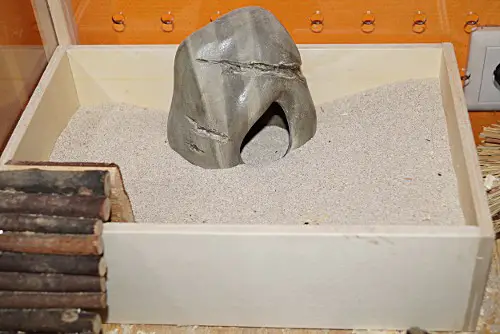

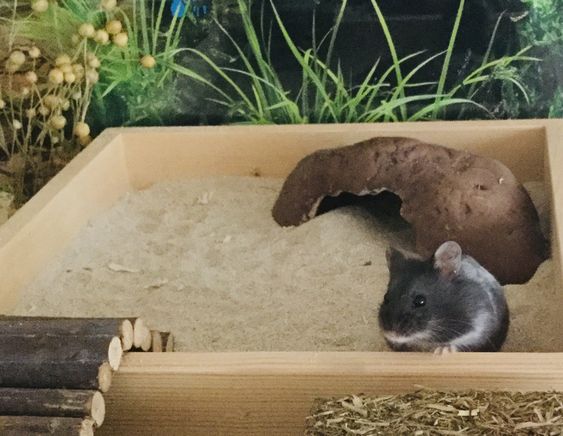
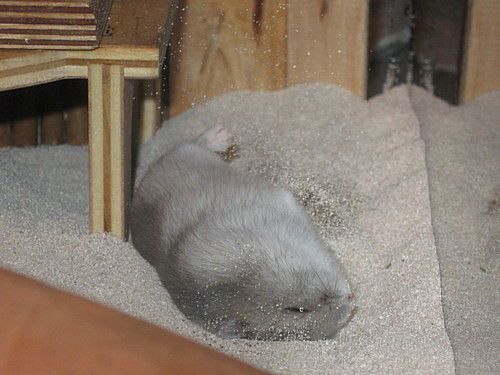
Which sand is better for hamsters?
The best and cheapest is the “children’s playsand”, the sand is sterilized, and there is no dust in it, just sift it as a precaution and put a good layer in the sandbox of your hamster.
The others are a bit expensive, like the one used for Chinchillas.
Avoid brands that use dyes, additives such as calcium, and those that are too fine-grained, and especially avoid dust.
Dusty sand will not fall off your hamster’s back, it will stick to its hair and create agglomerates that will hurt your hamster’s skin and make its fur dirtier and especially less insulating.
How to sterilize the sand of my hamster bath sand?
Just take the sand, spread it on a plate, use baking paper, and put the sand in the oven for at least 15 minutes at a temperature of more than 100°C.
Remove the sand, let it cool, sift it to remove dust, and then sift it to remove large pieces such as pieces of oyster shells, any bits of wood from the sea, algae … etc.
The sterilized sand should be kept in an airtight bag away from humidity.
Can I reuse my hamster’s sand?
Yes, but are you that cheap or is it just to help you out?
It was not expensive at all!!! but Ok, you can reuse the sand, sift it well and remove the places that smell like urine or that seem wet.
Pour the sand into a clean bag, clean the bin with water and vinegar ( half water, half vinegar ), let it dry, and put the sand back in.
Can I use sea beach or river sand for my hamster’s sand box?
Yes, you can use them but not directly!
The river sand has grains generally large, but the sand of the beaches is generally too fine!
You have to use sieves to have at the end and whose grain is ideal !! like the one of the children’s playsand.
You will then use another sieve to remove any possible big piece that could lacerate the skin of your hamster, such as the bits of shells … etc.
You will then fill a can with clean water and leave the sand in it for 24 hours in order to wash it well and rinse it the next day to remove all the dust and especially the salt if it is marine sand.
Wash it the next day, let it dry, and put it in the oven to sterilize it for 15 minutes at a temperature of about 350 F.
Take the sand out of the oven, let it cool down and you can use it.
How do I know if my hamster is taking his sand baths?
It’s simple, you will see your hamster enter the sandbox, roll around in it, throw sand on his back, shake, and have a good time in it!!! he will only not sing in the shower!!!
If not, a hamster that does not take sand baths, will not leave a trace in the sandbox and especially its fur will appear as if there are places where the hairs are stuck together.
His fur will not be smooth and he will have bits of leaves, stuff on his back and intertwined in his fur. He starts getting cold and won’t show up even at night.
He can even smell a little bad if you approach your nose to him!
What could prevent a hamster from taking his daily sand baths?
There are many things that can prevent a hamster from taking his sand baths, here are some reasons:
Fear of leaving the nest, which happens with new hamsters. Moving the sandbox closer to the entrance of your hamster’s nest and installing a small hideout in the sandbox can help and taming your hamster is the final solution.
Illness, old age, or injury can also prevent your hamster from taking his sand baths, if he has a back pain because of a bad exercise wheel that is too small or a fall, if he has a broken leg, if he is simply sick, in this case, you must help your hamster to take his sand baths, at least once or twice a day, especially if you see him trying to do it but he can’t!
Bad timing: I advise you to leave the sandbox permanently in the cage of your hamster. If your hamster wants to take his sand bath but he can’t find the container, he won’t do it just because you finally put his sandbox without the cage!
Final thoughts
You know, you can create your own sandbox for your hamster, then put it on the side of the cage where there is the least amount of bedding, away from his food and water bowl.
Hammies love these sand baths; it also helps them relax and avoid stress-related illnesses.
An older hamster may need help with sand bathing.
If your hamster has broken a leg, remove the sandbox until it heals.

